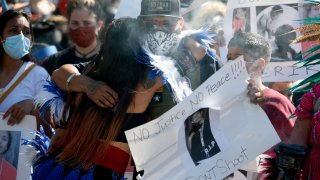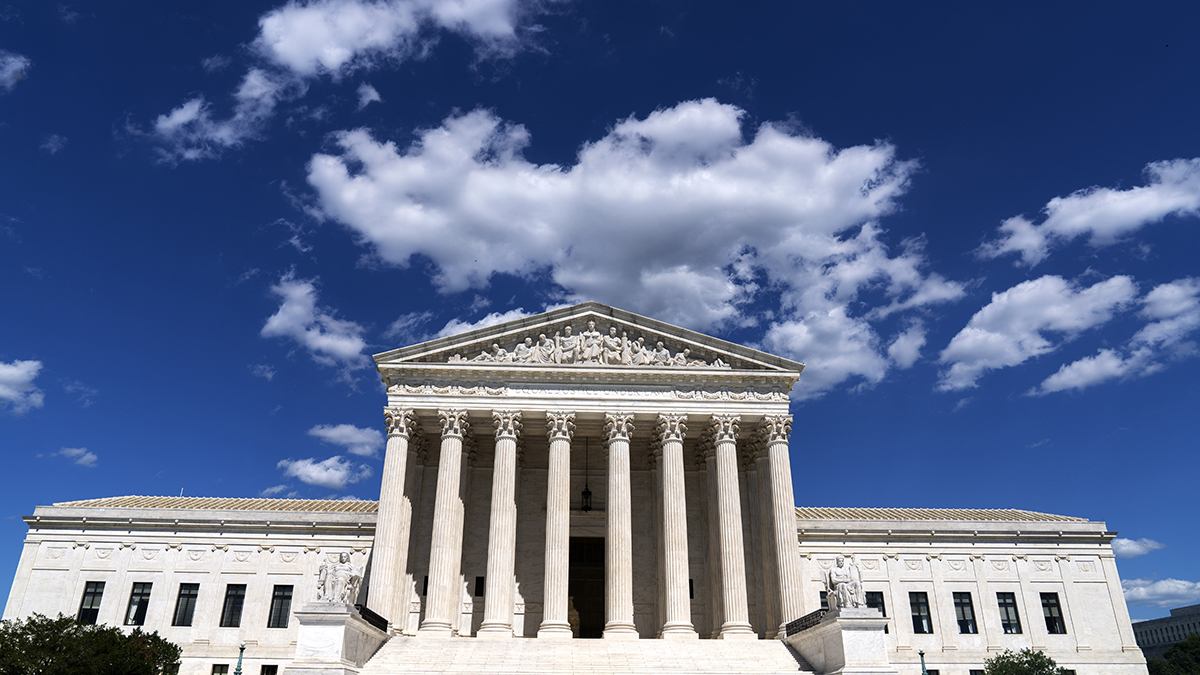
Forty-year-old Antonio Valenzuela’s death didn’t spark widespread protests like George Floyd’s. In fact, the police killing of Valenzuela drew little attention outside the American Southwestern city just north of the U.S.-Mexico border.
The details about Floyd's death, a 46-year-old Black man, who died in May at the hands of Minneapolis police closely resembles that of Valenzuela, a Mexican American man, who was killed in Las Cruces, New Mexico, three months before global protests and outrage. Like Floyd, Valenzuela died from a choking maneuver during an encounter with an officer after a struggle.
As national Black Lives Matter demonstrations grow, Latino activists are joining the multiracial protests while trying to draw attention to their deadly police encounters, some of which go back decades. Latino advocates and families of those killed by police say they aren't trying to pull the focus away from Black lives, but want to illustrate their own suffering from policing and systemic racism.
Activists say cases from Phoenix to Springfield, Massachusetts, point to patterns of violent interactions by police against Latinos similar to those of Black people. As with the killings of Black men and women, officers rarely face punishment in the death of Latinos. However, Latino cases seldom garner national attention, even when caught on video.
Get San Diego local news, weather forecasts, sports and lifestyle stories to your inbox. Sign up for NBC San Diego newsletters.
The lack of attention around Latinos and police highlights how little is known about Latino history in the U.S. and the racism endured in the American Southwest and the U.S.-Mexico border. It also marks the backlash some Mexican Americans face when trying to join the national conversation about race.
“It's like they don't care about Latinos and the racism we face,” said Frank Alvarado, Sr., 76, a retired U.S. Marine whose son was shot multiple times by Salinas, California, police in 2014 while holding a cellphone that officers claimed was a gun. Alvarado has since joined Black Lives Matter protests in nearby Sacramento.
According to the Washington Post, between 2015 and April 2020, Black Americans are killed at the highest rate in the U.S. (31 per million residents). Latinos are killed at the second-highest rate, 23 per million residents, according to the newspaper’s analysis. Both are disproportionate rates considering their percentages of the population.
U.S. & World
But Valenzuela's death embodies the lack of attention about Latinos' violent encounters with police. Las Cruces, a city where nearly 60% of residents are Hispanic, recorded a rate of police killings of 26.2 for every million residents. That was the highest rate for a city in the nation, the Washington Post reported.
New Mexico, a state with the largest percentage of Latino residents in the nation, also had the second-highest rate of all police killings, behind Alaska.
In the Valenzuela case, police video posted by the Las Cruces Sun-News shows officers chasing him after he fled from a traffic stop in February when he was found to have a parole violation. He was tasered twice but continued to struggle with officers.
Eventually, officers catch Valenzuela and Las Cruces police officer Christopher Smelser is heard saying, “I’m going to (expletive) choke you out, bro.” Valenzuela gasps for breath before going silent. The coroner determined he died from asphyxial injuries and also had methamphetamine in his system, which contributed to his death.
Smelser, who is also Hispanic, was fired and initially charged with involuntary manslaughter. Only after activists tied Valenzuela’s to Floyd's killing and Black Lives Matter protests hit Las Cruces did New Mexico Attorney General Hector Balderas file a second-degree murder charge against Smelser in July.
Smelser’s attorney, Amy L. Orlando, called the new charge a political move meant to grab headlines.
“Officer Smelser used a technique that was sanctioned by the department,” she said.
On Thursday, the city of Las Cruces and an attorney for Valenzuela’s family announced a settlement for an undisclosed amount. The city said it would work to adopt racial bias training for officers and seek to mandate that officers interfere with excessive force episodes or face termination.
Salinas, California, saw its string of police killings of Latinos get attention in the wake of Floyd's death. The small city of 160,000 people and known as the birthplace of Nobel laureate John Steinbeck saw police shoot four Latinos in 2014. Then there were others.
Ana Barrera, 48, an activist and middle school teacher, said the shootings awoke the normally quiet Latino farmworkers in Salinas who marched and expressed anger officers weren't facing discipline. She said immigration status and fear over losing easily replaced farm working jobs might have prevented some previously from speaking out. “That's changed now,” said Barrera, who has since organized meetings with Black Lives Matter organizers from Ferguson, Missouri.
Other cases have galvanized Latinos. In 2016, for example, protests flared up in Los Angeles' Boyle Heights neighborhood after an officer shot and killed Jesse Romero, a 14-year-old boypolice says was tagging graffiti behind an apartment complex. Los Angeles County prosecutors declined to charge the officer, Eden Medina, who said the boy fired at him — claim witnesses disputed.
In 2015, the city of Albuquerque agreed to pay $6 million to the family of Christopher Torres who was shot and killed by police four years before. In that case, Torres, who had been diagnosed with schizophrenia, was killed in his backyard when plainclothes detectives confronted him while serving a warrant connected to a road rage incident.
That shooting led to a U.S. Department of Justice investigation that concluded that Albuquerque police had a history of excessive force.
Throughout U.S. history, high-profile killings of Latinos by police have forced some departments to undergo massive reforms.
— In 1973, 12-year-old Santos Rodriguez died after Dallas Police Officer Darrell Cain forced him and his brother to play a game of Russian roulette over accusations they robbed $8 from a vending machine. The city erupted in riots amid demands for change.
— In 1978, Houston police faced calls to reforms and the city's North Side burst into mayhem a year after officers severely beat 23-year-old Mexican American and Vietnam veteran Joe Campos Torres and dumped his lifeless body in Buffalo Bayou.
Monica Muñoz Martinez, the author of “The Injustice Never Leaves You: Anti-Mexican Violence in Texas,” police killings of Latinos don't evoke the same emotion nationally because most Americans don't know about this violent history of the American West involving Latinos. “This country also can't discuss race outside of a Black-white binary,” Martinez said. “And that does not paint the true history of white supremacy.”
Marisol Márquez, an organizer with Los Angeles-based advocacy group Centro CSO Community Service Organization, said Mexican American activists know this history but felt immediately after Floyd's killing their needed to “center” Black Lives Matter when demonstrating against police violence.
On June 7, the group convened a Black Lives Matter protest outside of Mariachi Plaza in Los Angeles' Boyle Heights neighborhood. Aztec dancers, low riders, and elder pachucos gathered to remember Floyd and rally in support of the Black Lives Matter movement.
Black and Native American speakers addressed the crowd. But the high number of Latino speakers also drew a backlash.
“We got an angry message that said we really needed to have had way more speakers who were not Latino or Chicanos,” Márquez said. “I was so angry. Who they were referring to were people who had family members who had died at the hands of LAPD....Chicanos.”
___
Russell Contreras is a member of The Associated Press’ Race and Ethnicity Team. Follow him on Twitter at: http://twitter.com/russcontreras



